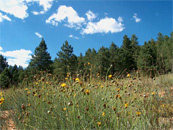All dried herbs are sensitive to heat, light, oxygen and water. Herbs have to be stored in airtight glass containers to retain their freshness, to stop humidity (molding), and to stop the dissipation of the herb's constituents into the air. Amber glass jars are excellent to store herbs, if you can not find any, store your herbs in any glass jar, paper bags, or plastic bags that are not airtight as plastic fumes will contaminate your herbs. As soon as you place your herbs in a glass container put a sticker with the name of the herb and the date.
I don't like my herbs to touch metal during storage or while making a tea, as they may react with the metals and oxidize, thus I don't recommend tin cans to store them. Regardless of the way that you store your herbs, they will slowly lose their potency and ultimately become worthless, don't use any herbs that are more than 8 months to a year old.
 |
Alegria (Amaranth): The dried, red flowers of Alegria are used mainly as an astringent. A strong infusion made by steeping the flower caps in hot water is taken for stomachaches, gas and especially diarrhea. Because of its bright color, our ancestors believed the use of Alegria would slow or stop bleeding. According to New Mexicans, the flower is a good aid in heart disorders. Indians used Alegria as a dye for ornaments used in their ceremonial tribe dances, and the women of these tribes cherished the pretty red flowers for making their cosmetics. |
 |
Anil Del Muerto (Goldweed): This grayish foliage has yellow flower heads and is generally grown in Northern New Mexico. An infusion of the boiled flower aids in disorders of the liver and in upset stomach. For pain and swelling caused by arthritis and rheumatism, a poultice is made with the weed. For this recipe, the leaves are crushed and sprinkled with lemon, salt, and vinegar. The mixture is then wrapped in a cloth and paced on the inflamed area. |
Azafran (Mexican Safflower): This Mexican herb is used for its diaphoretic actons to break high fevers that frequently occur during the cold season. An infusion made by steeping the flowers in hot water should be given to anyone with measles or chicken pox to help minimize the waiting period for the rash to come out of the skin. Azafran tea is said to be a popular ancient cure for insomnia.
Cascara Sagrada: Cascara Sagrada is a mild carminative that works effectively to clean the system when chronic constipation is not a problem. Boiling the leaves and adding a sprinkle of powdered gingerroot and canela makes a tasty tea.
Chamiso Heidondo: This native sage is highly pungent; hence, it's Spanish name, Chamiso Heidondo. A cold tea is made of the smelly sagebrush and drunk as a stomach bitter. Because the herb is diaphoretic, which means it promotes sweating, it is great for dry fevers and colds. Indians use Chamiso Heidondo regularly in their sweat bath ceremonies to cleanse their bodies by excreting wastes and toxins through the skin.
 |
Cota (Indian/Navajo tea): Before coffee was imported into New Mexico, Indians drank Cota tea on a regular basis as a leisure tea because of its great taste. A cup of warm tea with a touch of Piloncillo and Canela makes an excellent after-dinner drink or summer iced tea. New Mexicans use the tea as a remedy for mild stomach disorders and as a diuretic. Some Indian tribes use the plant as a dye. |
 |
Plumajillo (Yarrow): Plumajillo has been used for years to reduce fever, relieve arthritis, and regulate menstrual cycles. A tea of the herb is renowned as a bitter tonic used for any stomach disorder. The leaves of the plant are used in many poultices for healing external wounds, especially painful cuts and bruises. Because of its anti-inflammatory properties, a bath of the plant will alleviate the pain and swelling of rheumatism and hemorrhoids. |
Poleo (Rocky Mountain Brookmint): This pleasant smelling herb belongs to the mint family, and is a tasty addition to sun teas and cold beverages. Remedially, Poleo has been used for years to settle stomachaches, colic, and accompanying headaches. For fevers or beginning stages of colds, Poleo is either drunk or bathed in to increase perspiration, which in turn frees the body of waste and toxins. Because it is so gentle and tasty, Poleo is great in remedies for infants and children, but too much will act as an emetic.